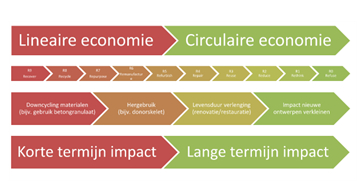Sustainable design
Circulair ontwerpen
The climate is changing. The influence of human activity on climate change becomes ever more clear. To prevent this (negative) influence, the use and construction of buildings needs to change drastically.
Worldwide - and therefore also in The Netherlands - there are several developments to make our built environment more sustainable. In Paris in 2015 agreements have been made to reduce the CO2 emission in the next couple of years (the so-called Paris Agreement). This resulted in several Dutch initiatives, among which the Deltaplan Duurzame Renovatie (DGBC), the Betonakkoord and the Bouwakkoord Staal.
As structural engineer, Zonneveld ingenieurs plays an important part in the design of new structures and renovation of existing structures in this transition of a lineair to a circular economy. Considering the building sector is responsible for approximately 40% of the total CO2 emission in The Netherlands, of which about a quarter from production of building elements and the building process. This does not only include the short-term impact, but also the impact in the long-term:

Hierbij hanteren wij verschillende ontwerpstrategieën:

De bijdrage van Zonneveld Ingenieurs ten aanzien van het reduceren van de milieu impact gaat verder waar de expertise van de duurzaamheidsadviseur ophoudt:
- Duurzame materialisatie van constructies (ontwerpen in bijvoorbeeld hout)
- Duurzaam grondstoffengebruik in de uitvoering (denk aan reduceren milieu impact betonmengsels)
- Optimalisatie van materiaalgebruik (afmetingen van constructieve elementen)
- Ontwerpen van adaptieve gebouwen (naar de toekomst toe flexibel in gebruik)
- Ontwerpen van demontabele gebouwen (hergebruik van constructieve elementen)
Om onze impact ook meetbaar te maken, hebben wij onze eigen tool ontwikkeld voor het bepalen van de milieu impact en de bouwkosten van onze ontwerpen, aan de hand van onze BIM modellen. Doordat de kosten en de duurzaamheidsprestatie van elke element in een database is vastgelegd worden met één handeling de bouwkosten en duurzaamheidsprestatie gepresenteerd. Met betrekking tot de duurzaamheid zijn dit de kgCO2, de Milieukosten Index (MKI) en de Milieuprestatie Gebouw (MPG) bepaald. Zo kunnen relatief snel bepaalde ontwerpkeuzes tegen elkaar worden afgewogen.
De afbeelding bovenaan deze pagina is ter illustratie een vergelijking tussen een traditioneel kantoorconstructie, en diezelfde constructie uitgevoerd in hout.
Onze betrokkenheid houdt niet op bij onze commerciële constructieprojecten.
Op dit moment wordt bijvoorbeeld in een team met stakeholders en experts gewerkt aan de ‘Open oproep werken aan wonen’ waarbij wordt onderzocht hoe bestaande portiekwoningen kunnen worden opgetopt en wordt samen met Energie van Rotterdam gestreefd naar maximaal eigenaarschap voor de Rotterdammers in de energietransitie.
Recycling
We believe in the development of a lineaire economy into a circulaire economy in which the recycling of raw materials is maximised. For our line of business, this specifically means the re-useability of buildings, structural elements and building materials. Klick here for more information.
Optimising Building Environment Performance
The Environment Performance for Buildings (MPG) indicates the strain on the environment of materials which are used in a building. The structure is one of the most important elements in the MPG-score. Zonneveld can calculate the different options and materials to enable the client to make the most optimal choice in the balance between building time, building costs and Environment Performance.
CO2 footprint
By combining the information from the virtual twin (geometry, amounts and use of materials) with information from the environmental impact of the materials, the CO2 footprint can be calculated. Zonneveld is able to very efficiently provide insight for all scenarios with advanced tools.
Energy efficiency
Besides the environmental impact of the materials, the energy efficiency during the life span of a building is essential for reducing energy use and costs. Zonneveld can calculate how you can optimally use energy saving components or for example the best structural possibilities for placing solar panels.
Investing in development
We cooperate in numerous projects and research in more sustainable buildings. One example is the development of insulating ‘Warmbeton’ at the Eindhoven university.
Design paviljoen in warm concrete First collective solar roof Noorderhavenkade Rotterdam
As partner of Blijstroom we participate in creating an zero energy city stad Rotterdam www.blijstroom.nl. Zonneveld checks if existing roofs can be used for solar panels, and what provisions may be needed if they cannot be used.
Circular designing
Increasing industrialisation will lead to an increase in the use of prefabricated products in the near future. Prefabricated elements can be regained through reuse. This process can be improved further if the design and detailing of these elements is optimised. Focus areas are among others the cohesion of the structure - which is at odds with a demountable frame - and the integration of technical installations in structural elements.
We strive for a design of structural elements that in future will be reuseable for many applications with a minimun of adaptations (Remake). Read here how high-rise has been built for the EPO project in Rijswijk with a steel frame made with cold stacked columns with elements with a height of 4 floors and beams mounted in trade lengths of 20m.